Synopsis
Traditionally, August fishing on Silver Creek becomes extremely active in the mornings with the onset of “Trico Madness”. This famous conflagration of tricorithodes spinners, in conjunction with other small mayflies, demands that anglers cast flies of the most diminutive proportions. However, it will be very much the opposite on our local freestones and tailwaters as we see a proliferation of larger insects, namely Grasshoppers. Thrown during the heat of the day, these terrestrials have been known to produce some violent strikes from the river. Regardless of location, the next few weeks of fly fishing will be very exciting!
Silver Creek
Any accomplished fisherman, who has not fished the Creek yet, should be waking early over the next three weeks as the Trico spinnerfall, one of Silver Creek’s true entomological signature spinner falls, is a wonder to behold. Although a little stingy lately, the Trico action has begun to heat up. Right now, the best window is between 8:00 a.m. and 10:30 a.m., depending on what section of the Creek you are fishing. At its peak, fishing will be superb from about 7:45 a.m. until 11:30 a.m.. Try dun patterns early in the fall cycle (sizes 20-22) and as the spinner fall progresses, move toward Trico spinners (size 20-22). You will notice, if you look at your legs, that Baetis emergers will also make a strong showing by crawling up your waders while the action is hot. Try rotating between Trico and Baetis patterns during this emergence in order to keep fish guessing and off-guard. Later in the morning, stay vigilant for PMDs which can promote more aggressive strikes as they sail downstream, offsetting themselves from the more petite Tricos and Baetis. After the madness subsides, try beetles and grasshoppers as well as Blue Damselflies in all sizes. Many savvy fishermen enjoy the frenetic action of August mornings at the Creek and then drive to the Big Wood for afternoon freestone hopper fishing.
Big Wood River
The Wood has been fishing well this summer despite a slow start to the season. Although the days of prolific Green Drake hatches are behind us, fishermen are having good success with Parachute Adams (size 16), Purple Hazes (size 16), Pink Alberts (size 16), PMDs (size 16-18) and Beige or Brown Elk Hair Caddis (size 12-16). These patterns can be productive throughout the day but especially in the mornings and the evenings. During the heat of the day, fish are tending to sulk in deeper pools, hang out near fast/slow water seams, or oxygenate themselves in fast riffles. When the hot summer sun beats down midday, try throwing grasshoppers in all of these locations. Although the majority of grasshoppers are not yet fully grown, use larger hopper patterns to bring wary fish to the surface. A distinctive “PLOP” when the imitation hits the water can trigger a trout’s carnivorous tendencies and convince even some of the largest fish to come to the surface. If this technique does raise any Rainbows, drop a nymph off the hopper’s hook shank and try the well-proven “Hopper/Dropper” method.
Big Lost River
The flow below the Mackay dam has been dropped to approximately 480 cfs making it possible to wade, but only for those experienced anglers with strong legs. If you venture into this stretch, use large nymphs and strike indicators or Craneflies fished in a quartering-down fashion. Also try large nymphs such as Prince Nymphs, King Princes and Flashback Pheasant Tails in size 12-16. Also, Zebra Midges in size 18-22 can be effective. San Juan Worms are also a good sub-surface option (size 12) while skating Craneflies (size 10) is another exciting pattern to use. PMDs and Parachute Adams in size 12-16 are also good producers.
East, West, and North Forks of the Big Lost
These high altitude tributaries of the Big Lost are fishing extremely well right now. Caddis (size 12-16), Gray Drakes (size 10-12), Brown Quills (size 14), PMDs (size 16), Yellow Sallies (size 14-16), Parachute Adams (size 12-16) and Grasshoppers are all bringing fish to the surface. During slower periods, try dropping a small brown mayfly nymph or caddis pupae from your dry fly.
South Fork of the Boise
The South Fork of the Boise is fishing well with Pink Alberts (size 16), Golden Stones (size 12-14) and the occasional Salmonfly (size 6-8) still bringing fish to the surface. Caddis can also be effective right now (sizes 12-16) in either beige or gray. When the activity subsides, try Woolly Buggers and streamers down deep. Bull Trout and Rainbows are susceptible to these fishy patterns and when they take they can darn near rip the rod right out of your hands.
Salmon River
The Salmon is fishing best during the cooler morning and evening hours with Beige Caddis (size 14-16) being the star of the show. Black Flying Ants also have significant presence in the mornings but can be fished all day. Grasshoppers are also good options as well as Yellow Sallies (size 14), PMDs (size 16) and other terrestrials like Cicadas and Crow Beetles in sizes 10-12. Hopper/dropper set ups are effective for hooking trout and whitefish, as is the lesser used Large Golden Stonefly/dropper configuration with Prince Nymphs or Pheasant Tails in size 12-16 hanging below.



